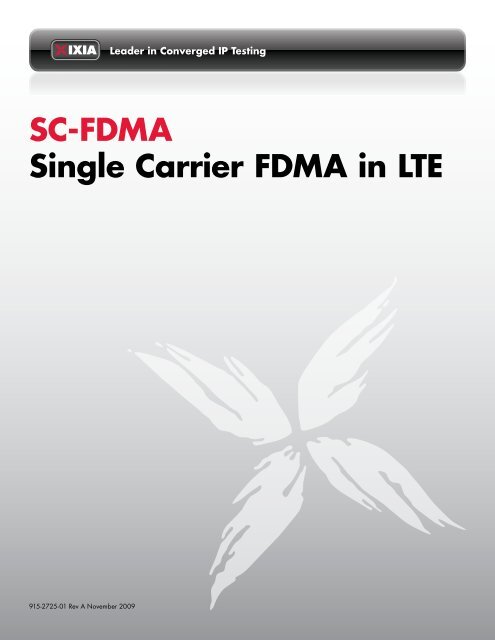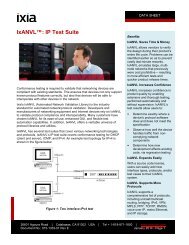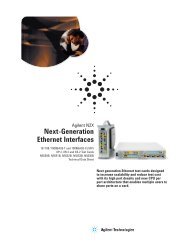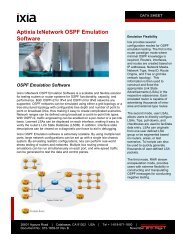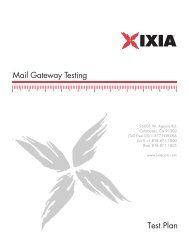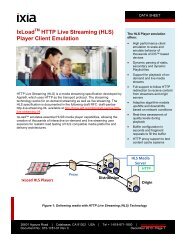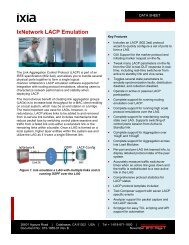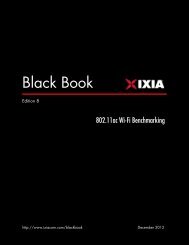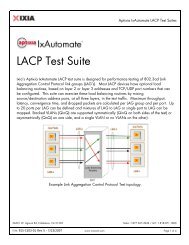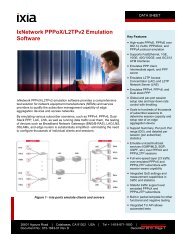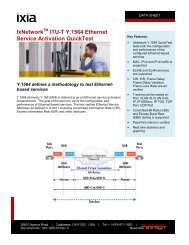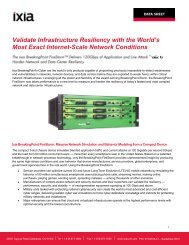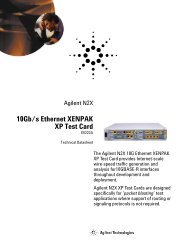SC-FDMA Single Carrier FDMA in LTE - Ixia
SC-FDMA Single Carrier FDMA in LTE - Ixia
SC-FDMA Single Carrier FDMA in LTE - Ixia
- No tags were found...
You also want an ePaper? Increase the reach of your titles
YUMPU automatically turns print PDFs into web optimized ePapers that Google loves.
ContentsIntroduction..............................................................................................43GPP Long Term Evolution ........................................................................4Upl<strong>in</strong>k Transmission...................................................................................5Why OFDM is most favored for broadband systems...................................7<strong>SC</strong>-<strong>FDMA</strong> Modulation................................................................................9OFDM.....................................................................................................10OFDM to <strong>SC</strong>-<strong>FDMA</strong>..................................................................................11Frequency Spread OFDM.........................................................................11Subcarrier Mapp<strong>in</strong>g................................................................................11<strong>S<strong>in</strong>gle</strong> <strong>Carrier</strong> Modulation........................................................................13PAPR analysis.........................................................................................14References..............................................................................................15
Introduction<strong>SC</strong>-<strong>FDMA</strong> is anew technologyused for upl<strong>in</strong>k <strong>in</strong><strong>LTE</strong>. This whitepaper exploresthis technology,its use <strong>in</strong> <strong>LTE</strong> andits extension fromOFDM.<strong>S<strong>in</strong>gle</strong> <strong>Carrier</strong> Frequency Division Multiple Access (<strong>SC</strong>-<strong>FDMA</strong>) is a promis<strong>in</strong>g technique forhigh data rate upl<strong>in</strong>k communication and has been adopted by 3GPP for it next generationcellular system, called Long-Term Evolution (<strong>LTE</strong>). <strong>SC</strong>-<strong>FDMA</strong> is a modified form of OFDMwith similar throughput performance and complexity. This is often viewed as DFT-codedOFDM where time-doma<strong>in</strong> data symbols are transformed to frequency-doma<strong>in</strong> by a discreteFourier transform (DFT) before go<strong>in</strong>g through the standard OFDM modulation. Thus,<strong>SC</strong>-<strong>FDMA</strong> <strong>in</strong>herits all the advantages of OFDM over other well-known techniques such asTDMA and CDMA. The major problem <strong>in</strong> extend<strong>in</strong>g GSM TDMA and wideband CDMA tobroadband systems is the <strong>in</strong>crease <strong>in</strong> complexity with the multipath signal reception. Thema<strong>in</strong> advantage of OFDM, as is for <strong>SC</strong>-<strong>FDMA</strong>, is its robustness aga<strong>in</strong>st multipath signalpropagation, which makes it suitable for broadband systems. <strong>SC</strong>-<strong>FDMA</strong> br<strong>in</strong>gs additionalbenefit of low peak-to-average power ratio (PAPR) compared to OFDM mak<strong>in</strong>g it suitablefor upl<strong>in</strong>k transmission by user-term<strong>in</strong>als.3GPP Long Term Evolution<strong>LTE</strong> is a next generation mobile system from the 3GPP with a focus on wireless broadband.<strong>LTE</strong> is based on Orthogonal Frequency Division Multiplex<strong>in</strong>g (OFDM) with cyclic prefix (CP)<strong>in</strong> the downl<strong>in</strong>k, and on <strong>S<strong>in</strong>gle</strong>-<strong>Carrier</strong> Frequency Division Multiple Access (<strong>SC</strong>-<strong>FDMA</strong>) withcyclic prefix <strong>in</strong> the upl<strong>in</strong>k. It supports both FDD and TDD duplex modes for transmission onpaired and unpaired spectrum.The generic radio frame has a time duration of 10 ms, consist<strong>in</strong>g of 20 slots of each 0.5ms. Two adjacent slots form a sub-frame of 1 ms duration, which is also one transmit-time<strong>in</strong>terval(TTI). Each slot consists of seven OFDM symbols with short/normal cyclic prefix(CP) or six OFDM symbols with long/extended CP.One radio frame - 10msSlot = .05ms#0#1 #2 #18 #19OFDM symbols <strong>in</strong> a slot#0 #1 #2 #3 #4 #5 #6OFDM symbolsCyclicprefixcopy<strong>in</strong>gFigure 1. <strong>LTE</strong> Frame Format4
Upl<strong>in</strong>k TransmissionThe upl<strong>in</strong>k transmission scheme is based on s<strong>in</strong>gle-carrier <strong>FDMA</strong>, more specifically DFTS-OFDM. The upl<strong>in</strong>k sub-carrier spac<strong>in</strong>g Δf = 15 kHz. There are two cyclic-prefix lengthsdef<strong>in</strong>ed: normal cyclic prefix and extended cyclic prefix correspond<strong>in</strong>g to seven and six<strong>SC</strong>-<strong>FDMA</strong> symbols per slot,N ULsymbrespectively. The cyclic prefix tim<strong>in</strong>gs for upl<strong>in</strong>k are the same as for the downl<strong>in</strong>k.For short cyclic prefix: T CP= 160×Ts for OFDM symbol l = 0= 144×Ts for OFDM symbol l = 1, 2,…6For long cyclic prefix: T CP-e= 512×Ts for OFDM symbol l = 0, 1…5T s= 1/ (2048 × Δf) is the sampl<strong>in</strong>g time for 20 MHz system.DFTSub- <strong>Carrier</strong>Mapp<strong>in</strong>gIFFTCP<strong>in</strong>sertionSymbolsFigure 2. Transmitter scheme of <strong>SC</strong>-<strong>FDMA</strong>The sub-carriers are grouped <strong>in</strong>to sets of 12 consecutive sub-carriers, correspond<strong>in</strong>g tothe upl<strong>in</strong>k resource blocks. 12 consecutive sub-carriers <strong>in</strong> one slot correspond to oneupl<strong>in</strong>k resource block – the same as <strong>in</strong> the downl<strong>in</strong>k – which is depicted <strong>in</strong> Figure 3. In thefrequency doma<strong>in</strong>, the maximum number of resource blocks, N RB, can range from N RB-m<strong>in</strong>= 6 to N RB-max= [110]. Each element <strong>in</strong> the resource grid is called a resource element andis uniquely def<strong>in</strong>ed by the <strong>in</strong>dex pair (k,l) <strong>in</strong> a slot where k and l are the <strong>in</strong>dices <strong>in</strong> thefrequency (subcarrier) and time doma<strong>in</strong> (symbol), respectively.5
One upl<strong>in</strong>k slot TslotN UL symb<strong>SC</strong>- <strong>FDMA</strong> symbolsULRBRBsck= N N -1Resource BlockNULsymbxNRBscresource elementsRBscsubcarrierssubcarrierssN x NULRBN RBscsResource element (k,l)k= 01= 0UL1= Nsymb-1Figure 3. Upl<strong>in</strong>k Slot format6
Why OFDM is most favored for broadband systemsSecond and third generation mobile systems are based on either TDMA or CDMA technologies.Although these technologies can theoretically be extended to next generationbroadband wireless systems, practical implementation issues and complexities limit theiracceptance. On the other hand, OFDM offers an easier solution and practical implementation.However, OFDM is not without its issues.Multipath signal propagation makes the channel response time dispersive; the amountof signal dispersion depends on the environment of operation. For example, the channeldispersion is about 5 micro seconds <strong>in</strong> typical urban areas and 15 to 20 microseconds<strong>in</strong> rural and hilly terra<strong>in</strong>. The factor that affects the receiver is the number of resolvablechannel taps over the channel dispersion <strong>in</strong>terval. In a TDMA system, it is the ratio of thechannel dispersion to signal symbol time. However, <strong>in</strong> a CDMA system, it is the number ofchannel taps with strong energy at chip-time resolution over the channel dispersion period.The channel time dispersion is viewed as the frequency selective or non-selective <strong>in</strong> thefrequency doma<strong>in</strong>. Frequency non-selective channel means the signal over its entire bandwidthwill have the same effect due to the multipath channel. This is also called flat fad<strong>in</strong>g.In the time doma<strong>in</strong>, the channel is not dispersive relative to its symbol time, and hence,there is no ISI. In the frequency selective channel, the signal will have <strong>in</strong>dependent effectsover its bandwidth due to the channel, and it is time dispersive relative to its symbol time.For narrowband TDMA systems such as GSM, multipath propagation makes the channelfrequency non-selective or less selective, mak<strong>in</strong>g the receiver less complex. Extend<strong>in</strong>gTDMA techniques to broadband system makes the receiver complexity unmanageable, asthe channel becomes very frequency selective. Let us take a closer look at this problem.GSM is a 200 kHz channel TDMA system with 270.833 kHz symbol rate with eitherb<strong>in</strong>ary GMSK or 8-PSK modulations. The baseband signal uses partial response signal<strong>in</strong>g,which spreads the symbol to three symbol periods. For a typical urban case with about 5us channel dispersion, the received signal can have signal dispersion of about 5 symbolperiods <strong>in</strong>clud<strong>in</strong>g its partial response signal<strong>in</strong>g. Hence, a typical GSM receiver requiresa 16-state MLSE equalizer for GMSK signal and an 8- or 64-state DFSE equalizer for an8-PSK EDGE signal. Suppose we want to scale up this technique to a wideband or broadbandsystem by factor of ten, i.e. a 2 MHz system with 2.70833 MHz symbol rate. For thesame amount of channel dispersion, the received symbol will be spread over 20 symbolperiods. The receiver with an equalizer for 20 channel taps will either be impractical toimplement or resort to <strong>in</strong>ferior methods. This problem can easily be dimensioned over a 20MHz broadband system.Similarly, WCDMA technique can also be extended to broadband systems, but its complexity<strong>in</strong>creases, as it requires more number of Rake receiver f<strong>in</strong>gers. Complexity, and oftenthe ga<strong>in</strong> of a Rake receiver, are based on the number of Rake f<strong>in</strong>gers the receiver canprocess. A typical WCDMA Rake receiver requires about 5-8 Rake f<strong>in</strong>gers for a typicalurban channel with dispersion of 5 microseconds. More advanced receivers, such as GeneralizedRake receivers, require even more f<strong>in</strong>gers as they try to place additional f<strong>in</strong>gersaround the desired signal, which are often called <strong>in</strong>terference f<strong>in</strong>gers. Extend<strong>in</strong>g WCDMA7
to a 20 MHz broadband system will require higher chip rates, mean<strong>in</strong>g that it can resolvechannel taps with f<strong>in</strong>er resolution. This results <strong>in</strong> more f<strong>in</strong>gers for the Rake receiver withstrong signal energy. Therefore, extension of WCDMA/HSPA systems to a 20 MHz broadbandsystem requires extension of similar factor on the number of f<strong>in</strong>gers <strong>in</strong> Rake receiver,and thus its complexity. 3GPP is <strong>in</strong> the process of def<strong>in</strong><strong>in</strong>g other ways of extend<strong>in</strong>g HSPAsystem to broadband systems, based on multi-carrier HSPA.OFDM has become a most favored technique for broadband wireless system due to susceptibilityto signal dispersion under multipath conditions. OFDM can also be viewed asa multi-carrier narrowband system where the whole system bandwidth is split <strong>in</strong>to multiplesmaller subcarriers with simultaneous transmission. Simultaneous data transmission andreception over these subcarriers are handled almost <strong>in</strong>dependently. Each subcarrier isusually narrow enough that multipath channel response is flat over the <strong>in</strong>dividual subcarrierfrequency range, i.e. frequency non-selective. Another way to look at is that an OFDMsymbol time is much larger than the typical channel dispersion. Hence OFDM is <strong>in</strong>herentlysusceptible to channel dispersion due to multipath propagation.One major difference between an OFDM and the TDMA or CDMA techniques is importantto note. In traditional systems the symbol detection is on the samples at either symbol orchip rate, and it cares about the carrier-to-<strong>in</strong>terference level only at the sampl<strong>in</strong>g po<strong>in</strong>ts.But, OFDM symbol detection requires that the entire symbol duration be free of <strong>in</strong>terferencefrom its previous symbols, a.k.a. <strong>in</strong>ter-symbol <strong>in</strong>terference. Even though OFDM symbolduration is much larger than channel dispersion, even a small amount of channel dispersioncauses some spill<strong>in</strong>g of each OFDM symbol to the next symbol, thus it causes someISI. However this ISI spill-over is limited to only the <strong>in</strong>itial part of the neighbor<strong>in</strong>g symbol.Hence this ISI spill-over at the beg<strong>in</strong>n<strong>in</strong>g of each symbol can easily be removed by add<strong>in</strong>ga cyclic prefix to each transmit symbol. Cyclic prefix is the process of extend<strong>in</strong>g eachsymbol by duplicat<strong>in</strong>g a portion of the signal at the symbol ends, which is thrown awayat the receiver. The amount of symbol extension, i.e. length of cyclic prefixes, is a systemdesign parameter, and it is based on the expected signal dispersion <strong>in</strong> the environment ofsystem operation. For example, the <strong>LTE</strong> system uses OFDM symbol of 66 microseconds plus5 microseconds of cyclic prefix. This means it is susceptible to maximum signal dispersionof 5 microseconds due to multipath channel propagation.8
<strong>SC</strong>-<strong>FDMA</strong> Modulation<strong>SC</strong>-<strong>FDMA</strong> is a new multiple access technique that utilizes s<strong>in</strong>gle carrier modulation, DFTspreadorthogonal frequency multiplex<strong>in</strong>g, and frequency doma<strong>in</strong> equalization. It has asimilar structure and performance as OFDM. <strong>SC</strong>-<strong>FDMA</strong> is currently adopted as the upl<strong>in</strong>kmultiple access scheme for 3GPP <strong>LTE</strong>. Transmitter and receiver structure for <strong>SC</strong>-<strong>FDMA</strong> andOFDM are given <strong>in</strong> Figures 4 and 5. It is evident from the figures that <strong>SC</strong>-<strong>FDMA</strong> transceiverhas similar structure as a typical OFDM system except the addition of a new DFT blockbefore subcarrier mapp<strong>in</strong>g. Hence, <strong>SC</strong>-<strong>FDMA</strong> can be considered as an OFDM system witha DFT mapper.Data Block InMod SymbolMapp<strong>in</strong>gDFTSub-carrierMapperIFFTCyclicPrefixP/S&DACRFI-QModChannelData Block OutIDFT &DetectionEqualizerSub-carrierDemapFFTCPRemoveADC&S/PRFI-QModFigure 4. <strong>SC</strong>-<strong>FDMA</strong> Transmitter and ReceiverData Block InMod SymbolMapp<strong>in</strong>gSub-carrierMapperIFFTCyclicPrefixP/S&DACRFI-QModChannelData Block OutDetectionEqualizerSub-carrierDemapFFTCPRemoveADC&S/PRFI-QDemodFigure 5. OFDM Transmitter and Receiver9
O<strong>FDMA</strong>s <strong>SC</strong>-<strong>FDMA</strong> is built over OFDM modulation, let’s first review an OFDM system structure. Atypical OFDM transmitter and receiver structure is shown <strong>in</strong> Figure 2. A transmitter <strong>in</strong>cludesa baseband modulator, subcarrier mapp<strong>in</strong>g, <strong>in</strong>verse Fourier transform, cyclic prefix addition,parallel-serial conversion, and a digital-to-analog converter followed by an I-Q RFmodulator. Unlike other modulation techniques that operate symbol by symbol, OFDMtransmits a block of data symbols simultaneously over one OFDM symbol. An OFDMsymbol is the time used to transmit all of subcarriers that are modulated by the block of<strong>in</strong>put data symbols.The baseband modulator transforms the <strong>in</strong>put b<strong>in</strong>ary bits <strong>in</strong>to a set of multi-level complexnumbers that corresponds to different modulations formats such as BPSK, QPSK, 16- or64-QAM.The type of modulation format used often depends on the signal-to-noise level of thereceived signal and the receiver ability to decode them correctly. These modulated symbolsare then mapped to subcarriers. An <strong>in</strong>verse-FFT (IFFT) is used to transform the modulatedsubcarriers <strong>in</strong> frequency doma<strong>in</strong> to time doma<strong>in</strong> samples.In general, the same modulation format is used <strong>in</strong> all the subcarriers to keep the control<strong>in</strong>formation overhead small. However, it is possible to have different modulation formatsover multiple subcarriers, and it is <strong>in</strong> fact advantageous <strong>in</strong> harsh and time vary<strong>in</strong>g channelconditions. In a broadband system, the channel is frequency selective over its large systembandwidth, mean<strong>in</strong>g the signal fad<strong>in</strong>g on each subcarrier is <strong>in</strong>dependent. The <strong>in</strong>terferencelevel on each subcarrier can also be different and vary uniquely with time. It results <strong>in</strong> a differentsignal-to-impairment level on each of the subcarriers. Hence, hav<strong>in</strong>g an appropriatemodulation format on these subcarriers would help to maximize the overall system throughput.OFDM system <strong>in</strong>herits an adaptation of modulation formats to each of the subcarriersdepend<strong>in</strong>g on channel conditions, and this is called Channel-dependent schedul<strong>in</strong>g.A cyclic prefix block copies a portion of the samples at the end of the time doma<strong>in</strong> samplesblock (at the IFFT output) to the beg<strong>in</strong>n<strong>in</strong>g. S<strong>in</strong>ce the DFT/FFT outputs are periodic <strong>in</strong>theory, copy<strong>in</strong>g the samples to the beg<strong>in</strong>n<strong>in</strong>g will make the signal cont<strong>in</strong>uous. The lengthof the cyclic prefix depends on the channel delay spread, and is preferably longer thanthe length of the channel response. At the receiver, the prefix part of the symbol is thrownaway as it may conta<strong>in</strong> ISI from its previous symbol. Hence, it removes the effect of ISIcaused by the multipath signal propagation. However, the prefix is the overhead <strong>in</strong> anOFDM system, as it does not carry any useful <strong>in</strong>formation.The block of complex samples are then serialized <strong>in</strong> the time doma<strong>in</strong> and convertedto analog signals. The RF section modulates the I-Q samples to f<strong>in</strong>al transmission radiofrequency. A correspond<strong>in</strong>g receiver does the <strong>in</strong>verse operations of the transmitter <strong>in</strong> thereverse order. A typical OFDM receiver <strong>in</strong>cludes an RF section, ADC, parallel-to-serialconverter, cyclic prefix remover, Fourier transformer, sub-carrier demapper, equalizer anddetector.10
OFDM to <strong>SC</strong>-<strong>FDMA</strong>The ma<strong>in</strong> difference between OFDM and <strong>SC</strong>-<strong>FDMA</strong> transmitter is the DFT mapper. Aftermapp<strong>in</strong>g data bits <strong>in</strong>to modulation symbols, the transmitter groups the modulation symbols<strong>in</strong>to a block of N symbols. An N-po<strong>in</strong>t DFT transforms these symbols <strong>in</strong> time doma<strong>in</strong> <strong>in</strong>tofrequency doma<strong>in</strong>. The frequency doma<strong>in</strong> samples are then mapped to a subset of M subcarrierswhere M is typically greater than N. Similar to OFDM, an M-po<strong>in</strong>t IFFT is used togenerate the time-doma<strong>in</strong> samples of these subcarriers, which is followed by cyclic prefix,parallel to serial converter, DAC and RF subsystems.Frequency Spread OFDMEach data symbol is DFT transformed before mapp<strong>in</strong>g to subcarriers, hence the <strong>SC</strong>-<strong>FDMA</strong>is called DFT-precoded OFDM. In a standard OFDM, each data symbol is carried on a separatesubcarrier. In <strong>SC</strong>-<strong>FDMA</strong>, multiple subcarriers carry each data symbol due to mapp<strong>in</strong>gof the symbols’ frequency doma<strong>in</strong> samples to subcarriers. As each data symbol is spreadover multiple subcarriers, <strong>SC</strong>-<strong>FDMA</strong> offers spread<strong>in</strong>g ga<strong>in</strong> or frequency diversity ga<strong>in</strong> <strong>in</strong> afrequency selective channel. Thus, <strong>SC</strong>-<strong>FDMA</strong> can be viewed as frequency-spread OFDM orDFT-spread OFDM.Subcarrier Mapp<strong>in</strong>gDFT output of the data symbols is mapped to a subset of subcarriers, a process calledsubcarrier mapp<strong>in</strong>g. The subcarrier mapp<strong>in</strong>g assigns DFT output complex values as theamplitudes of some of the selected subcarriers. Subcarrier mapp<strong>in</strong>g can be classified <strong>in</strong>totwo types: localized mapp<strong>in</strong>g and distributed mapp<strong>in</strong>g. In localized mapp<strong>in</strong>g, the DFToutputs are mapped to a subset of consecutive sub-carriers thereby conf<strong>in</strong><strong>in</strong>g them to only afraction of the system bandwidth. In distributed mapp<strong>in</strong>g, the DFT outputs of the <strong>in</strong>put dataare assigned to subcarriers over the entire bandwidth non-cont<strong>in</strong>uously, result<strong>in</strong>g <strong>in</strong> zeroamplitude for the rema<strong>in</strong><strong>in</strong>g subcarriers. A special case of distributed <strong>SC</strong>-<strong>FDMA</strong> is called<strong>in</strong>terleaved <strong>SC</strong>-<strong>FDMA</strong>, where the occupied subcarriers are equally spaced over the entirebandwidth. Figure 6 is a general picture of localized and distributed mapp<strong>in</strong>g.11
00fromDFTtoIFFTfromDFTL-1 ZerostoIFFTL-1 Zeros0L-1 ZerosL-1 ZerosFigure 6. Localized mapp<strong>in</strong>g vs. Distributed mapp<strong>in</strong>gAn example of subcarrier mapp<strong>in</strong>g is shown <strong>in</strong> Figure 7. This example assumes three usersshar<strong>in</strong>g 12 subcarriers. Each user has a block of four data symbols to transmit at a time.The DFT output of the data block has four complex frequency doma<strong>in</strong> samples, which aremapped over 12 subcarriers us<strong>in</strong>g different mapp<strong>in</strong>g schemes.<strong>SC</strong>-<strong>FDMA</strong> <strong>in</strong>herently offers frequency diversity ga<strong>in</strong> over the standard OFDM, as all<strong>in</strong>formation data is spread over multiple subcarriers by the DFT mapper. However, thedistributed <strong>SC</strong>-<strong>FDMA</strong> is more robust with respect to frequency selective fad<strong>in</strong>g and offersadditional frequency diversity ga<strong>in</strong>, s<strong>in</strong>ce the <strong>in</strong>formation is spread across the entire systembandwidth. Localized <strong>SC</strong>-<strong>FDMA</strong> <strong>in</strong> comb<strong>in</strong>ation with channel-dependant schedul<strong>in</strong>g canpotentially offer multi-user diversity <strong>in</strong> frequency selective channel conditions.x 0x 1x 2x 3Time doma<strong>in</strong> symbols (4 symbols block)DFTa 0a 1a 2a 3Frequency doma<strong>in</strong> samplesSubcarrier Mapp<strong>in</strong>g (12 subcarriers)Localized Mapp<strong>in</strong>ga 0a 1a 2a 1 0 0 0 0 0 0 0 0f 1 f 2 f 3 f 4 f 5 f 6 f 7 f 8 f 9 f 10 f 11 f 12Subcarrier b<strong>in</strong>s = >Interleaved Mapp<strong>in</strong>ga 0 0 0 a 1 0 0 a 2 0 0 a 3 0 0f 1 f 2 f 3 f 4 f 5 f 6 f 7 f 8 f 9 f 10 f 11 f 12Subcarrier b<strong>in</strong>s = >Figure 7. Subcarrier Mapp<strong>in</strong>g Example12
<strong>S<strong>in</strong>gle</strong> <strong>Carrier</strong> ModulationBased on <strong>SC</strong>-<strong>FDMA</strong>’s structure, the reasons for some of its names, such as DFT-precodedOFDM or DFT-spread OFDM, are clear. But for the use of ‘<strong>S<strong>in</strong>gle</strong> <strong>Carrier</strong>’ <strong>in</strong> its name, <strong>SC</strong>-<strong>FDMA</strong>, is not as obvious and is often the reason why is not expla<strong>in</strong>ed,. Unlike the standardOFDM where the each data symbol is carried by the <strong>in</strong>dividual subcarriers, the <strong>SC</strong>-<strong>FDMA</strong>transmitter carries data symbols over a group of subcarriers transmitted simultaneously. Inother words, the group of subcarriers that carry each data symbol can be viewed as onefrequency band carry<strong>in</strong>g data sequentially <strong>in</strong> a standard <strong>FDMA</strong>. For some of the subcarriermapp<strong>in</strong>gs, the time doma<strong>in</strong> representation of the IFFT output, as shown <strong>in</strong> Figures 8 and9, will give more <strong>in</strong>sight on the <strong>SC</strong>-<strong>FDMA</strong> signal. It can be mathematically shown that the<strong>SC</strong>-<strong>FDMA</strong> baseband time doma<strong>in</strong> samples after IDFT or IFFT is the orig<strong>in</strong>al data symbol setrepeated <strong>in</strong> time doma<strong>in</strong> over the symbol period.x 0x 1x 2x 3Time doma<strong>in</strong> symbols (4 symbols block)DFTa 0a 1a 2a 3Frequency doma<strong>in</strong> samplesInterleaved Subcarrier Mapp<strong>in</strong>g over 12 subcarriersa 00 10 2a 1 0 0 a 2 0 0 a 3 0 0f 1 f 2 f 3 f 4 f 5 f 6 f 7 f 8 f 9 f 10 f 11 f 12IDFTx 0x 1x 2x 3x 0x 1x 2x 3x 0x 1x 2x 3Time doma<strong>in</strong> samples => {Sn}Figure 8. Time doma<strong>in</strong> representation of Interleaved <strong>SC</strong>-<strong>FDMA</strong>Data Block InMod SymbolMapp<strong>in</strong>gDFTSub-carrierMapperIFFTCyclicPrefixP/S&DACRFI-QModData Block InMod SymbolMapp<strong>in</strong>gSymbolRepetitionCyclicPrefixP/S&DACRFI-QModFigure 9. Simplified Interleaved <strong>SC</strong>-<strong>FDMA</strong> Transmitter13
PAPR analysis<strong>SC</strong>-<strong>FDMA</strong> offers similar performance and complexity as OFDM. However, the ma<strong>in</strong>advantage of <strong>SC</strong>-<strong>FDMA</strong> is the low PAPR (peak-average-power ratio) of the transmit signal.PAPR is def<strong>in</strong>ed as the ratio of the peak power to average power of the transmit signal. AsPAPR is a major concern at the user term<strong>in</strong>als, low PAPR makes the <strong>SC</strong>-<strong>FDMA</strong> the preferredtechnology for the upl<strong>in</strong>k transmission. PAPR relates to the power amplifier efficiency at thetransmitter, and the maximum power efficiency is achieved when the amplifier operates atthe saturation po<strong>in</strong>t. Lower PAPR allows operation of the power amplifier close to saturationresult<strong>in</strong>g <strong>in</strong> higher efficiency. With higher PAPR signal, the power amplifier operat<strong>in</strong>gpo<strong>in</strong>t has to be backed off to lower the signal distortion, and thereby lower<strong>in</strong>g amplifierefficiency. As <strong>SC</strong>-<strong>FDMA</strong> modulated signal can be viewed as a s<strong>in</strong>gle carrier signal, a pulseshap<strong>in</strong>g filter can be applied to transmit signal to further improve PAPR.PAPR comparison between OFDM and <strong>SC</strong>-<strong>FDMA</strong> variations such as <strong>in</strong>terleaved <strong>SC</strong>-<strong>FDMA</strong>and localized <strong>SC</strong>-<strong>FDMA</strong> has been done <strong>in</strong> [2]. With no pulse shap<strong>in</strong>g filters, <strong>in</strong>terleaved-<strong>SC</strong>-<strong>FDMA</strong> shows the best PAPR. Compared to OFDM PAPR, the PAPR of <strong>in</strong>terleaved <strong>SC</strong>-<strong>FDMA</strong> with QPSK is about 10 dB lower, whereas that of localized <strong>SC</strong>-<strong>FDMA</strong> is only about3 dB lower. With 16-QAM, these levels are about 7 dB and 2 dB lower respectively.Therefore, <strong>in</strong>terleaved <strong>SC</strong>-<strong>FDMA</strong> is a preferred modulation technique for lower PAPR.Pulse shape filter<strong>in</strong>g of <strong>SC</strong>-<strong>FDMA</strong> <strong>in</strong> fact degrades the PAPR level of <strong>in</strong>terleaved <strong>SC</strong>-<strong>FDMA</strong>whereas it shows no effect with localized <strong>SC</strong>-<strong>FDMA</strong>.References[1] Jens Berkmann, et al., “On 3G <strong>LTE</strong> Term<strong>in</strong>al Implementation – Standard, Algorithms,Complexities and Challenges”, IWCMC 2008 Mobile Comput<strong>in</strong>g Symposium, 2008[2] Hyung G. Myung, Junsung Lim, and David J. Goodman, “<strong>S<strong>in</strong>gle</strong> <strong>Carrier</strong> <strong>FDMA</strong> forUpl<strong>in</strong>k Wireless Transmission.” IEEE Vehicular Technology, Sept 2006[3] 3GPP TR 25.912 v 7.1.0, “Feasibility study for evolved Universal Terrestrial RadioAccess (UTRA) and Universal Terrestrail Radio Access Network (UTRAN),” Release 7[4] 3GPP TS 36.300 v8.7.0, “Evolved Universal Terrestrial Radio Access (E-UTRA) andEvolved Universal Terrestrial Radio Access Network (E-UTRAN); Overall description; Stage2,” Release 8[5] 3GPP TS 36.211 v8.4.0, “Evolved Universal Terrestrial Radio Access (E-UTRA); PhysicalChannels and Modulation,” Release 8[6] 3GPP TS 36.212 v8.4.0, “Evolved Universal Terrestrial Radio Access (E-UTRA); Multiplex<strong>in</strong>gand Channel cod<strong>in</strong>g,” Release 8[7] 3GPP TS 36.213 v8.4.0, “Evolved Universal Terrestrial Radio Access (E-UTRA); Physicallayer procedures,” Release 814
<strong>Ixia</strong> Worldwide Headquarters26601 Agoura Rd.Calabasas, CA 91302(Toll Free North America)1.877.367.4942(Outside North America)+1.818.871.1800(Fax) 818.871.1805www.ixiacom.comOther <strong>Ixia</strong> ContactsInfo: <strong>in</strong>fo@ixiacom.comInvestors: ir@ixiacom.comPublic Relations: pr@ixiacom.comRenewals: renewals@ixiacom.comSales: sales@ixiacom.comSupport: support@ixiacom.comTra<strong>in</strong><strong>in</strong>g: tra<strong>in</strong><strong>in</strong>g@ixiacom.com


